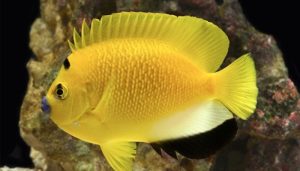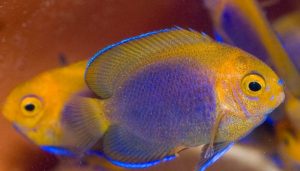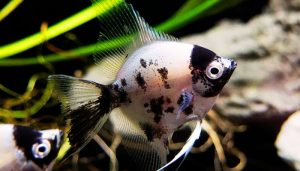A common question among fishkeepers is whether ghost shrimp breed on their own in a community tank. When setting up a community tank, many aquarists wonder about the compatibility and breeding habits of various species.
Ghost shrimp may breed in a community tank, but survival of larvae is unlikely due to predation and lack of optimal conditions for development.
One intriguing inhabitant that often catches the eye is the ghost shrimp, known for its translucent body and playful behavior.
Palaemonetes paludosus inhabits fresh water or mildly brackish waters, typically found in lakes. While these shrimp are indeed capable of breeding in appropriate conditions, several factors come into play, including tank mates, water parameters, and the availability of suitable hiding spots for their young.
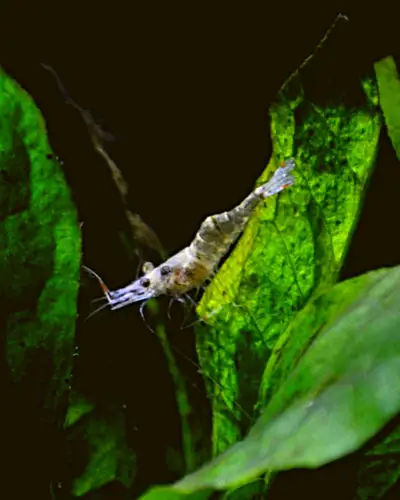
In this article, we will explore the breeding behavior of ghost shrimp, the conditions necessary for successful reproduction, and the potential challenges you may encounter in a mixed-species environment.
Understanding these dynamics can help you create a thriving aquatic ecosystem where both shrimp and fish can coexist harmoniously.
Table of Contents
ToggleDo Ghost Shrimp Breed Easily?
Are ghost shrimp easy to breed? Ghost shrimp are known to reproduce with relative ease under the right conditions. When kept in a suitable environment, a female ghost shrimp can produce a significant number of eggs, which makes them a favorite for those interested in breeding freshwater shrimp.
However, the ease of breeding largely depends on the presence of optimal water conditions and a well-maintained aquarium setup. Factors such as temperature, water quality, and the presence of algae can influence their ability to breed.
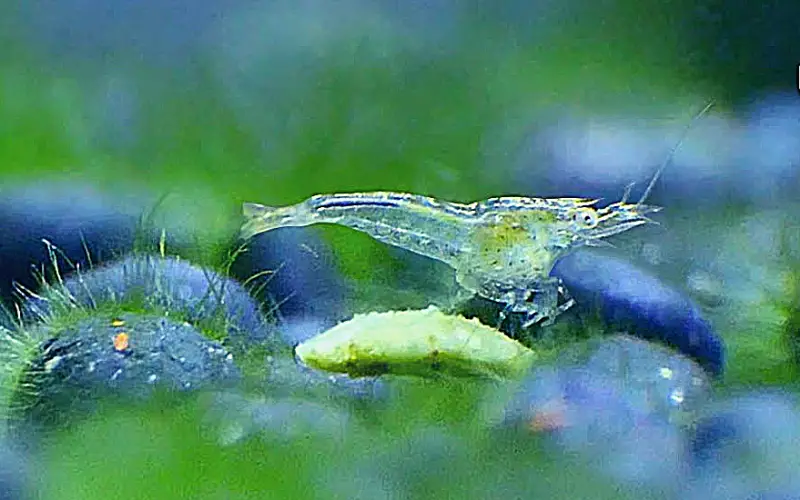
Furthermore, ensuring that the ratio of male to female shrimp is balanced can also enhance the likelihood of successful reproduction.
In addition to environmental conditions, the presence of other aquatic life can impact ghost shrimp reproduction process. While they are generally compatible with many species, aggressive tank mates may stress them, reducing their chances of reproduction.
Providing a densely planted tank can create hiding spots, allowing ghost shrimp to feel secure and more likely to breed. Thus, hobbyists should focus on creating a peaceful environment that mimics their natural habitat to encourage breeding behavior.
How Do Ghost Shrimp Reproduce?
Ghost shrimp reproduce through a process that involves several stages. Here’s an overview of how ghost shrimp reproduce:
Mating:
- Male ghost shrimp will seek out a female when she is ready to mate. The female releases pheromones into the water to signal her readiness.
- The male will then deposit sperm packets (spermatophores) near the female’s reproductive opening.
Egg Fertilization:
- The female releases eggs, which pass through the sperm packets, resulting in fertilization.
- The fertilized eggs are then attached to the female’s pleopods (swimmerets) under her abdomen.
Egg Carrying:
- The female carries the eggs with her for about 2-3 weeks. During this time, she will fan the eggs to keep them oxygenated and clean.
- The eggs will gradually change color, starting from a greenish hue and becoming more opaque as they develop.
Hatching:
- After the incubation period, the eggs hatch into larvae. The larvae are very tiny and free-swimming.
- Unlike adult ghost shrimp, the larvae go through several planktonic stages before they develop into juvenile shrimp.
Larval Development:
- The larvae need to be in brackish water (a mix of fresh and saltwater) to survive and develop properly. This is a critical stage, and many larvae may not survive if the conditions are not right.
- Over the course of a few weeks, the larvae will molt several times and gradually develop into miniature versions of adult ghost shrimp.
Juvenile Stage:
- Once the larvae have fully developed into juvenile shrimp, they can be moved back to freshwater if they were raised in brackish water.
- The juveniles will continue to grow and molt periodically until they reach adulthood.
Important Considerations:
- Tank Conditions: To successfully breed ghost shrimp, maintain clean water with stable parameters. Provide hiding places and ensure the tank is free from predators that might eat the larvae.
- Separation: If you want to increase the survival rate of the larvae, consider separating the pregnant female or the larvae from the main tank to protect them from being eaten by other tank inhabitants.
Breeding ghost shrimp can be a rewarding experience, but it requires attention to detail, especially during the larval stages.
Will Ghost Shrimp Breed in a Community Tank?
Yes, Glass shrimp can breed in a community tank, but the success of breeding often depends on the tank’s overall dynamics. Community tanks featuring ghost shrimp, cherry shrimp, and other peaceful species can create a harmonious environment conducive to breeding.
It’s essential to monitor the interactions between different species, as some may pose a threat to shrimp, potentially disrupting their breeding cycles. Additionally, the presence of compatible species can help maintain a balanced ecosystem, which is beneficial for the breeding process.
While breeding ghost shrimp and other freshwater shrimp in a community tank is achievable, it’s crucial to provide sufficient space and power filter. A well-planted aquarium with ample hiding spots can improve the chances of successful breeding.
If the breeding tank is overcrowded or filled with aggressive species, it may hinder the breeding process. Therefore, careful consideration of tank mates and maintaining a peaceful environment will increase the likelihood of shrimp breeding successfully in a community setup.
Can Ghost Shrimp Breed in Freshwater?
Do ghost shrimp breed in freshwater? Yes, ghost shrimp are able to breed in freshwater environments, which makes them a popular choice for freshwater aquarium enthusiasts. Female ghost shrimp carry fertilized eggs, which develop into larvae after hatching.
These larvae are capable of swimming freely in the water column, where they feed on microscopic organisms like infusoria. The presence of a stable and clean freshwater environment is crucial to ensure the survival of both the larvae and the adult shrimp, as poor water quality can negatively affect their reproductive success.
Moreover, the breeding process is facilitated by the right parameters, including pH, temperature, and water hardness. Maintaining these factors within optimal ranges will encourage the female to carry her eggs to term.
Once the eggs hatch, the ghost shrimp fry will begin to swim and forage for food, highlighting the importance of a well-established ecosystem in the aquarium. Thus, with proper care and attention, ghost shrimp can thrive and reproduce successfully in a freshwater tank.
How Often Do Ghost Shrimp Breed?
Ghost shrimp are capable of breeding multiple times throughout the year, especially when conditions are favorable. A female ghost shrimp can lay hundreds of eggs per breeding cycle, typically every four to six weeks, depending on water conditions and food availability.
Once the eggs are fertilized, they will remain attached to the female’s tail until they hatch, usually within 2 to 3 weeks. This frequent breeding cycle can lead to a rapid increase in the ghost shrimp population if conditions remain stable.
It’s essential for aquarium owners to be prepared for the potential influx of ghost shrimp fry, as a successful breeding cycle can result in numerous baby shrimp. Providing ample fry food sources, such as alga and infusoria, will ensure that both adult shrimp and their young can thrive.
If you have a well-maintained tank with proper parameters, you’ll likely witness the fascinating life cycle of ghost shrimp unfold before your eyes, making it an exciting endeavor for any aquarist.
What Size Tank for Ghost Shrimp Breeding?
When it comes to breeding ghost shrimp, a minimum tank size of 10 gallons is recommended to provide adequate space for the shrimp to thrive. A larger tank allows for more stable water parameters, which is crucial for the successful reproduction of shrimp species.
Additionally, a 10-gallon tank gives the shrimp ample room to swim, forage, and hide, creating a more natural environment that encourages reproducing behavior. It’s also beneficial to include live plants, such as java moss as they can provide sponge filter to help maintain water quality.
A reproducing tank specifically designed for ghost shrimp can also benefit from proper filtration and aeration. Keeping the water clean and well-oxygenated is vital for the health of both adult shrimp and their fry.
Moreover, adding decorations or hiding spots will reduce stress among the shrimp, further enhancing their reproducing capabilities. Thus, investing in a suitable tank setup is essential for anyone looking to successfully breed glass shrimp.
How to Breed Ghost Shrimp?
Breeding ghost shrimp requires careful attention to environmental conditions and tank setup. First, ensure that your aquarium has stable water parameters, including appropriate pH levels, temperature, and hardness.
A temperature range of 70-78°F is ideal for promoting breeding among ghost shrimp. Next, introduce a balanced male-to-female ratio in the tank, as having more females than males can lead to successful breeding outcomes.
Providing a diet rich in nutrients, including algae and high-quality shrimp food, will also support the health of the shrimp and encourage reproducing.
Once the female ghost shrimp is ready to reproduce, she will carry her fertilized eggs under her tail until they hatch into larvae. It’s essential to keep the tank well-maintained during this period to ensure the survival of the fry.
After the eggs hatch, the ghost shrimp fry will require tiny food particles, such as infusoria, to thrive. Regularly monitoring the tank conditions and feeding the fry will help ensure a successful breeding experience and contribute to a flourishing ghost shrimp population.
Conclusion
In conclusion, ghost shrimp can breed on their own in a community tank, provided that the conditions are conducive to their reproduction. By maintaining a suitable freshwater environment, ensuring a balanced male-to-female ratio, and providing adequate nutrition, aquarium enthusiasts can successfully encourage ghost shrimp breeding. While they are able to breed in community tanks, careful consideration of tank mates and overall tank dynamics is essential for fostering a thriving shrimp population. With the right knowledge and commitment, any hobbyist can enjoy the delightful experience of watching ghost shrimp breed and thrive in their aquarium.
You might also like
- How Long Do Glass Shrimp Live: (Prolong Their Lifespan)
- Caring for Ghost Shrimp 101: A Complete Guide & Breeding Tips
- Pregnant Ghost Shrimp Stages: (5 Successful Breeding Tips)
- Lifespan of Ghost Shrimp Guide: Excellent Tips You Can’t-Miss
- Ghost Shrimp Pregnancy: Signs, Care, Stages, And More!
- What Does Ghost Shrimp Eat: Top 5 Foods For Optimal Health
- How to Raise Ghost Shrimp: 5 Proven Tips for Maximum Profit!


